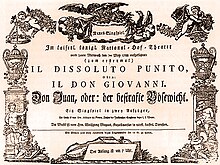| Don Giovanni | |
|---|---|
| Opera by W. A. Mozart | |

Portrait of Francisco D'Andrade in the title role by Max Slevogt, 1912
| |
| Librettist | Lorenzo Da Ponte |
| Language | Italian |
| Premiere | 29 October 1787 Estates Theatre, Prague |
Don Giovanni (Italian pronunciation: [dɔn dʒoˈvanni]; K. 527; complete title: Il dissoluto punito, ossia il Don Giovanni, literally The Rake Punished, namely Don Giovanni or The Libertine Punished) is an opera in two acts with music by Wolfgang Amadeus Mozart and Italian libretto by Lorenzo Da Ponte. It is based on the legends of Don Juan, a fictional libertine and seducer. It was premiered by the Prague Italian opera at the National Theater (of Bohemia), now called the Estates Theatre, on 29 October 1787.[1] Da Ponte's libretto was billed as a dramma giocoso, a common designation of its time that denotes a mixing of serious and comic action. Mozart entered the work into his catalogue as an opera buffa. Although sometimes classified as comic, it blends comedy, melodrama and supernatural elements.
A staple of the standard operatic repertoire, Don Giovanni for the five seasons 2011/12 through 2015/16 was ninth on the Operabase list of the most-performed operas worldwide.[2] It has also proved a fruitful subject for writers and philosophers.
Contents
Composition and premiere[edit]
The opera was commissioned as a result of the overwhelming success of Mozart's trip to Prague in January and February 1787.[3] The subject matter may have been chosen in consideration of the long history of Don Juan operas in Prague; the genre of eighteenth-century Don Juan opera originated in Prague.[4]
The libretto of Lorenzo Da Ponte was based closely on a libretto by Giovanni Bertati for the opera Don Giovanni Tenorio, first performed in Venice early in 1787, although he was loath to admit this in memoirs written decades later.[5] Some of the most important elements that he copied were the idea of opening the drama with the murder of the Commendatore (in earlier dramas, this incident always appeared somewhere in the middle) and the lack of a specification of Seville as the setting, which had been customary in the tradition of Don Juan dramas since the appearance of the prototype Don Juan drama El burlador de Sevilla by Tirso de Molina, written in the early 17th century. For Bertati, the setting was Villena, Spain, whereas Da Ponte's libretto only specifies a "city in Spain".[6]
Don Giovanni was originally to have been performed on 14 October 1787 for a visit to Prague of the Archduchess Maria Theresa of Austria, niece of the Emperor Joseph II, and her new husband, Prince Anthony of Saxony; however, the production could not be prepared in time and Le nozze di Figaro was substituted instead on the order of the emperor himself.[7] The score was completed on 28 or 29 October 1787 after Da Ponte was recalled to Vienna to work on another opera. Reports about the last-minute completion of the overture conflict; some say it was completed the day before the premiere,[8] some on the very day. More likely it was completed the day before, in light of the fact that Mozart recorded the completion of the opera on 28 October.[3]
The score calls for double woodwinds, two horns, two trumpets, three trombones (alto, tenor, bass), timpani, basso continuo for the recitatives, and the usual string section. The composer also specified occasional special musical effects. For the ballroom scene at the end of the first act, Mozart calls for two onstage ensembles to play separate dance music in synchronization with the pit orchestra, each of the three groups playing in its own metre (a 3/4 minuet, a 2/4 contradanse and a fast 3/8 peasant dance), accompanying the dancing of the principal characters. In act 2, Giovanni is seen to play the mandolin, accompanied by pizzicato strings. In the same act, two of the Commendatore's interventions ("Di rider finirai pria dell'aurora" and "Ribaldo, audace, lascia a' morti la pace") are accompanied by a wind chorale of oboes, clarinets, bassoons, and trombones (with cellos and basses playing from the string section). The instrumentation and vocal writing are very reminiscent of Mozart's treatment of the voice of Neptune in Idomeneo.[citation needed]
The opera was first performed on 29 October 1787 in Prague under its full title of Il dissoluto punito ossia il Don Giovanni – Dramma giocoso in due atti (The Rake punished, or Don Giovanni, a dramma giocoso in two acts). The work was rapturously received, as was often true of Mozart's work in Prague (See Mozart and Prague). The Prager Oberpostamtzeitung reported, "Connoisseurs and musicians say that Prague has never heard the like," and "the opera … is extremely difficult to perform."[9] The Provincialnachrichten of Vienna reported, "Herr Mozart conducted in person and was welcomed joyously and jubilantly by the numerous gathering."[10]

Comments
Post a Comment